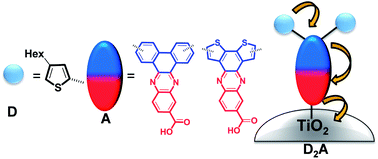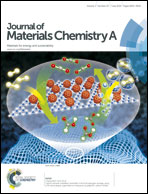Quadrupolar (donor)2acceptor-acid chromophores for dye-sensitized solar cells: influence of the core acceptor†
Abstract
A series of four quadrupolar (Donor)2Acceptor-acid (D2A) sensitizers, based on two acceptor cores (dibenzophenazine (DBP) or dithienophenazine (DTP)), were synthesized and their optoelectronic and photovoltaic properties were investigated. 4-Hexyl-thien-2-yl groups were employed as donor units, to produce regioisomers depending on their connecting position to the core. This architectural design leads to the investigation of the structure–property relationships of the dyes, both in solution and upon integration in dye-sensitized solar cells (DSSCs). Within sets of regioisomers, frontier orbital levels and absorption properties differed, but the photovoltaic performances of the DSSCs were similar. When examining the effect of the core, the electronic properties (absorbance, LUMO level) predicted a more favourable electron injection for the DTP systems. However, the open circuit voltages are ∼100 mV greater for the DBP systems.


 Please wait while we load your content...
Please wait while we load your content...